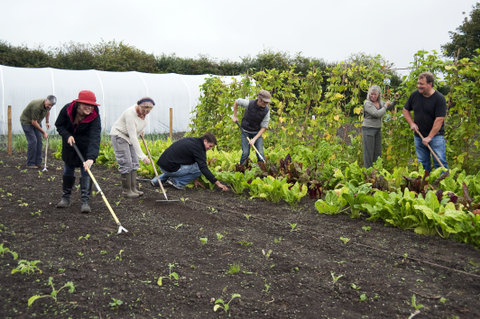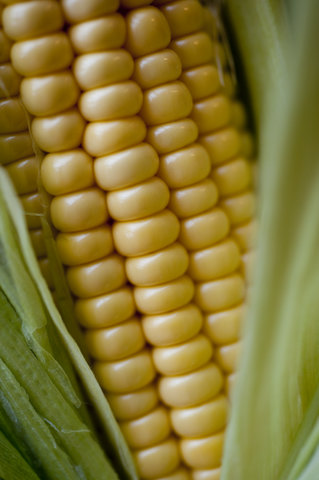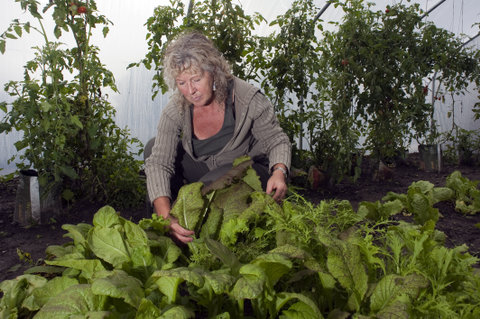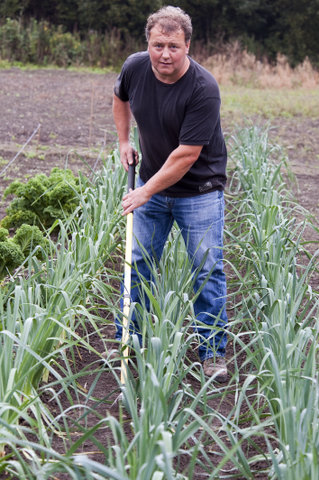
Volunteers keeping their crops weed free. Photographs: Charles Francis
November 2010: It is known as the Golden Mile: a south-facing stretch of sheltered, spectacularly fertile land on the fringes of Penzance, which can comfortably produce two crops a year. Last winter, a group of novice horticulturalists were given the opportunity to take over a field in this favoured place. This summer, they enjoyed a bumper harvest of potatoes and tomatoes, broad beans and beetroot, courgettes and sweetcorn, runner beans, spinach and chard.

A perfect corn cob grown by the PEaT Project
The PEaT Project was launched by Penwith Community Development Trust in February to give practical help to people who are interested in growing their own produce, but have little idea how to go about it: the letters in the title stand for Plant, Eat and Teach.
This year’s pilot scheme has been so successful that PCDT has now secured funding for the at least another two years, which will enable more plots to be cultivated at the site, in the village of Gulval.
Carole Oldridge joined the project after she was made redundant from her job as a kitchen assistant at a Penzance restaurant. “I thought it might be time for a change, and I started to look for courses in horticulture,” she says. “I saw an employment advisor at PCDT, and he told me about the PEaT Project.
“I came along in April, and I’ve been involved ever since. Every week you learn new things: how to plant, how to nurture, how to control pests — it’s fantastic. I hope to get into doing this as a career.”
Project co-ordinator Val Johnson says: “We wanted to provide good basic instruction on growing veg, in a friendly, relaxed atmosphere. It can also be a stepping stone for anyone who is interested in a career change. One of my main objectives was that people who come want to work on the site; they are not here because someone told them to come.”
The seeds of the scheme were sown when PCDT was planning the celebrations for its 10th birthday in October last year, as Val explains. “We had been running a project teaching people the basics of cookery, and we decided it would be good to get some of them to create food for the celebration,” she said. “Afterwards, I thought: ‘Wouldn’t it be nice to get people growing food?’
“A local farmer offered us a field, and very kindly ploughed it for us. But the field had been fallow for some time, and a lot of work had to be done to make it suitable for growing vegetables.”
One of the team’s first tasks was to divide the field into four plots, using the time-honoured principles of crop rotation. At the beginning, on-site facilities were basic, consisting only of an ancient army tent, where the trainee horticulturalists often had to seek shelter. “In March and April we had some very wet days,” Val remembers. “There were times when everyone just huddled together in the tent and looked out onto the muddy field!
“When the weather cleared up, we decided to work on a small section of the field and plant things which would give us an immediate return, like broad beans and potatoes. Plot 1 has yielded a terrific amount of veg, and part of it has now been reworked for planting with spring greens and other brassicas. Then we started working on Plot 2. It’s given us a good supply of sweetcorn, courgettes, Florence fennel and leeks.”

Val checking lettuces in the polytunnel
Val brings to the project a lifetime’s love of gardening: she has fond childhood memories of freshly-harvested vegetables grown by her mother. “Whenever I was living somewhere where I didn’t have much of a garden, I would grow veg in pots,” she says. “My other love is cooking. I’m a great believer in fresh food well cooked, and if I can impart some of that love to other people, I see it as a job well done.
“So many young people today don’t know how to prepare fresh vegetables and don’t realise how simple it is to make a good nutritious meal. Many recipes, including good winter soups and casseroles, are based on simple basics, and are easy once you know how.
“We intend to do some cookery sessions here, for example, teaching people how to make tomato and basil sauce, and basic dough, so they can make their own pizza. We will also be running accredited courses in horticulture for those who wish to enhance their CV, and one-day workshops on subjects such as herb-growing and growing in containers, as well as fun things like mosaic-making — as we work the land, we are finding thousands of shards of pottery.”
These fragments are a legacy of the horticultural practices of more than a century ago, when market gardeners living along the Golden Mile would bring sand and seaweed up from nearby beaches to enrich the soil, and then add a layer of waste from local refuse tips, including broken china.
Local community groups interested in growing their own vegetables are now being invited to have their own mini-plot. “We also want to work with people who may have health issues,” says Val, “the ethos being that working in the open air is good for mind, body and soul.”
People working at the site no longer have to squash into an old tent when weather conditions are wrong for sowing. They can now shelter in a Portakabin with a fitted kitchen, thanks to Dennis Tresidder. Dennis is a landscape contractor and former allotment-holder, who also has experience of training young people in amenity horticulture and working on community projects with Penwith Housing Association and Cornwall Neighbourhoods for Change.

Dennis tending the hundreds of leeks he has grown
Dennis has installed the water system and overseen the erection of a polytunnel, which will enable the PEaT Project to grow through the winter and make an early start on the spring veg. He says he couldn’t have done it without the help of the volunteers. “Sometimes you need several pairs of hands to get things done. That’s what happens here all the time. It’s a lovely site, and there’s a nice laid-back atmosphere.”
Carole agrees: ”When I was working in the kitchens at the restaurant, it was hot and I was under pressure. But here it’s very calming, very therapeutic, and very grounding — literally. Every time something happens, whether it’s a success or a disappointment, you learn something. If you see something growing well, it’s brilliant. If something dies, you think: ‘What went wrong there?’
“Val is an excellent teacher. She’s very hands-on, and very patient. She doesn’t mind you asking a really inane question, which you do when you first start.”
Like Carole, most would-be growers came to the project through Penwith Community Development Trust’s employment advisor team, or through Penwith Volunteer Bureau, which is based at the trust’s offices in Penzance.
Among them is Claire Benson, an active community volunteer who became enthused about growing vegetables after working on the Living Churchyards project, where she learned to cook nettle soup and make sloe wine.
She describes the PEaT Project as “brilliant”. “You learn as you go — hoeing, planting out veg, weeding. I’d now like to learn more about botanical names, maybe do an NVQ in horticulture.”
Claire is not only learning a lot: her qualifications in print-making and ceramics mean she has much to offer the project in return. “There is a stretch of clay at the bottom of the field,” she says. “Hopefully, we will be able to make pottery and have a kiln. I’d like to run workshops here, and also take visitors round to do sketching.”
The project’s current funding, from West Cornwall Local Action for Rural Communities, pays for Val to be on site for two days a week, and Dennis for one. Val is now investigating other possible funding sources. “We could really do with the site being worked on more,” she says. “We have groups interested in coming here five days a week.” Gulval School is keen to be involved, as is the John Daniel Centre in Penzance, which provides services for adults with learning disabilities. Dennis says: “We work in an organic and pesticide-free manner, and that means it’s labour-intensive. If we could get more hours, it would be brilliant. The John Daniel Centre would like their people to come here and grow things, and then sell them at farmers’ markets. It would be lovely if that could happen.”